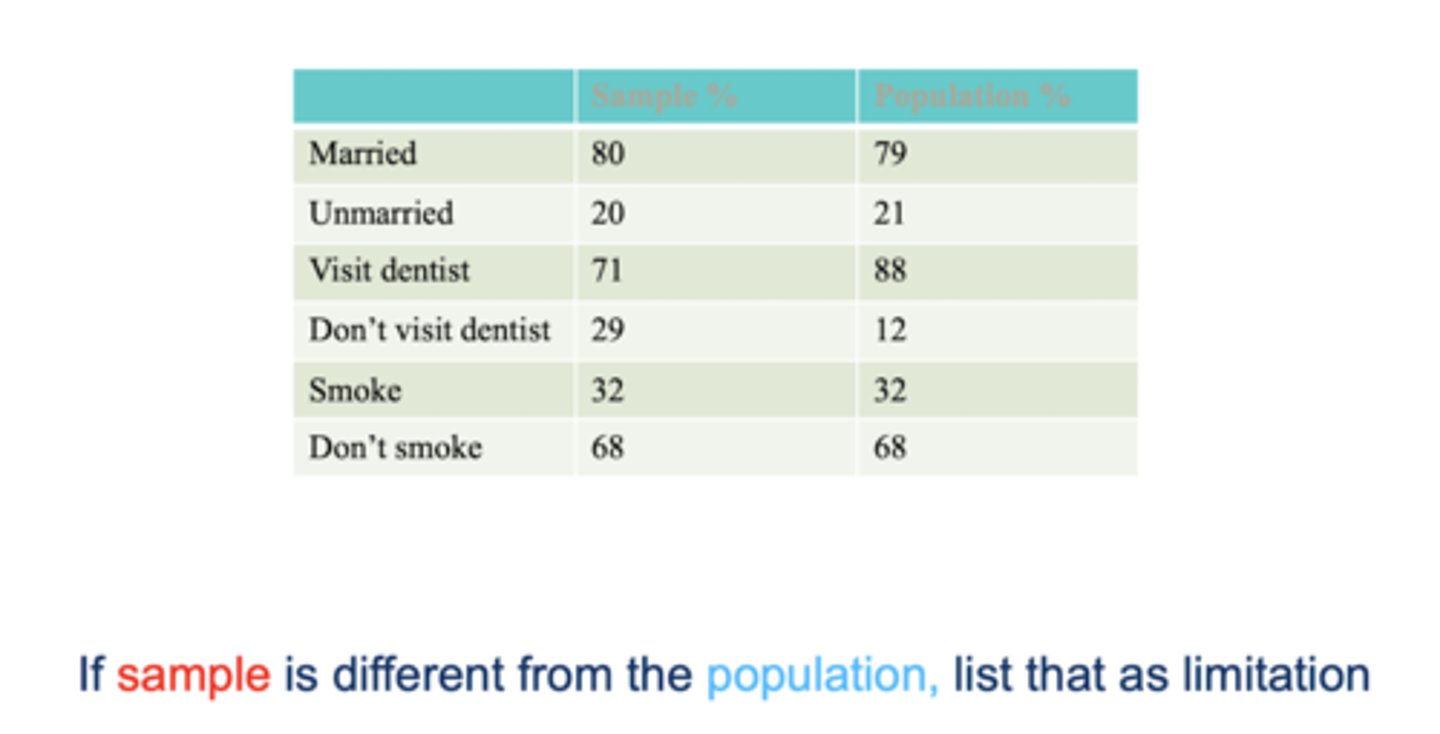Research Quiz #2: Literature Search Skills, Research Design, Intro to Stats, Critical Appraisal
1/117
There's no tags or description
Looks like no tags are added yet.
Name | Mastery | Learn | Test | Matching | Spaced |
|---|
No study sessions yet.
118 Terms
Why do we use PubMed?
- The professional standard and starting place and is designed to include biomedicine and health sciences
- Detailed inclusion/exclusion criteria
- Search algorithm is disclosed
- Discloses clear data management policies
T/F: We should use GoogleScholar
False!
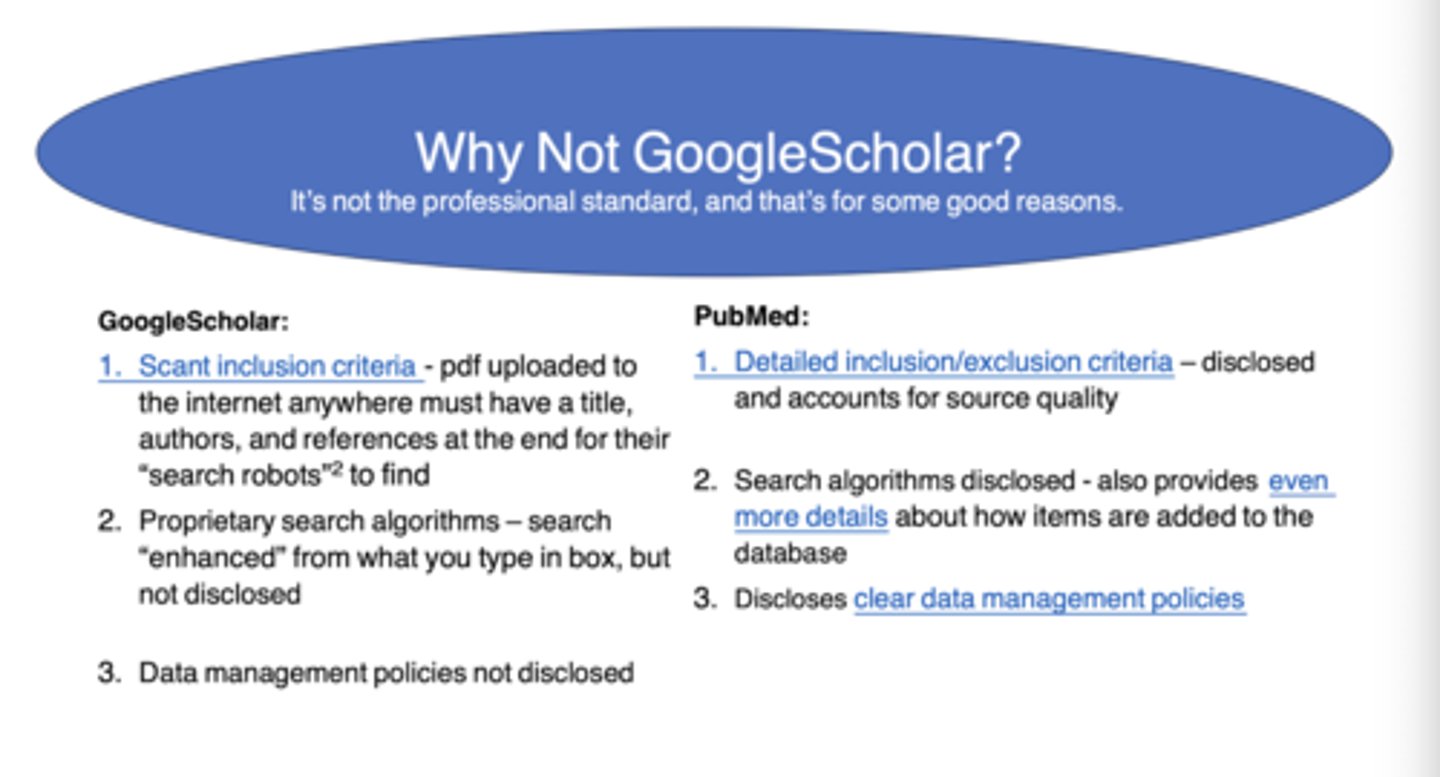
How can you search on PubMed?
- Put your research question into its individual PICO parts and search each of those first and use the "add to query box" and then "add to history" for the rest
- This allows you to see what all is available for each part of your question
How do you limit and find the most relevant research topics?
By combining parts of the PICO question with "AND"
When would you want to use "OR" in your search?
Use "OR" when you want to search for articles with a synonym of the research question or trying to expand upon that part of the research question radiographs OR X-Rays
Adjusting a Search (Broadening Technique)
1. Adjust an initially selected search term to be broader
2. Combine synonyms and/or broader terms with an initial search term with OR
3. Eliminate the search term that is the least strategically important to the search strategy
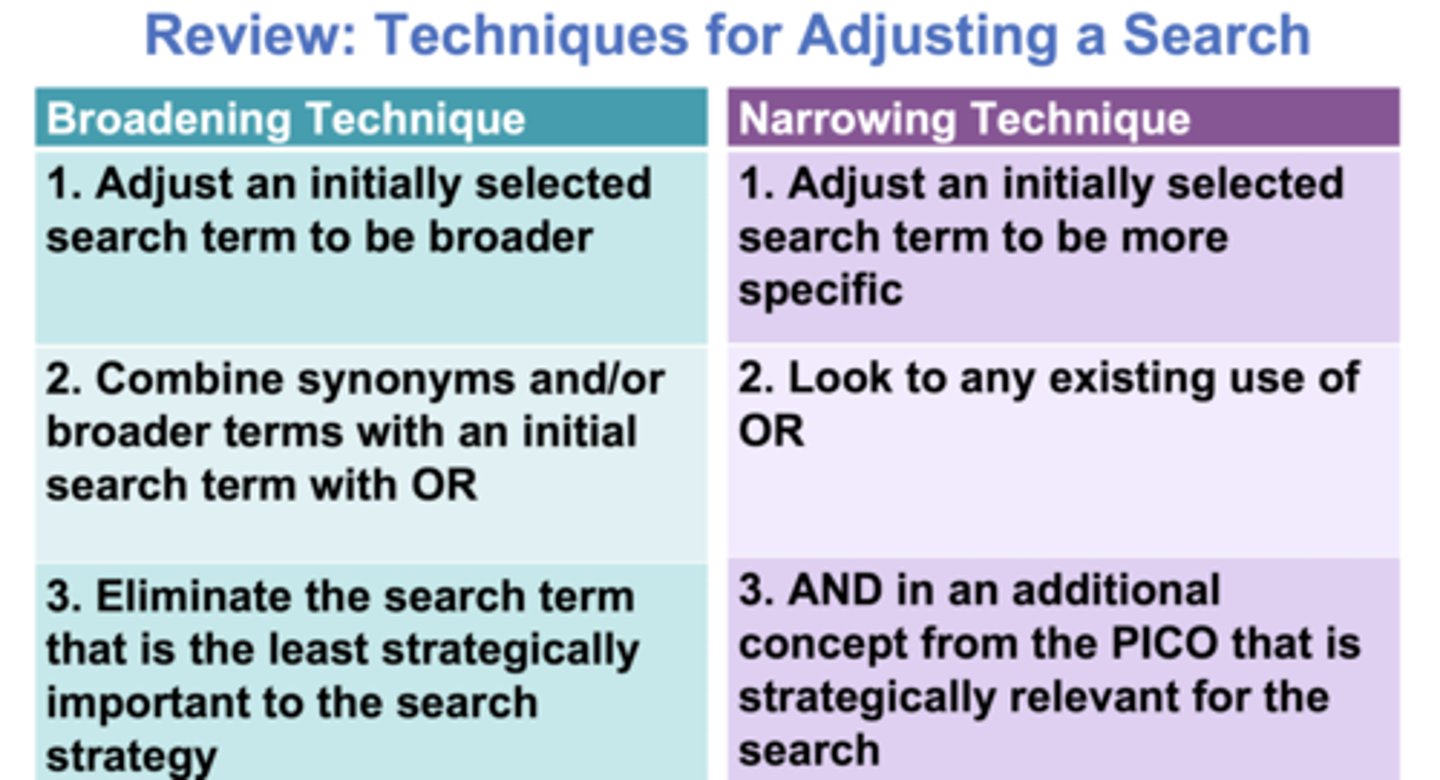
Adjusting a Search (Narrowing Technique)
1. Adjust an initially selected search term to be more specific
2. Look to any existing use of OR
3. AND in an additional concept from the PICO that is strategically relevant for the search
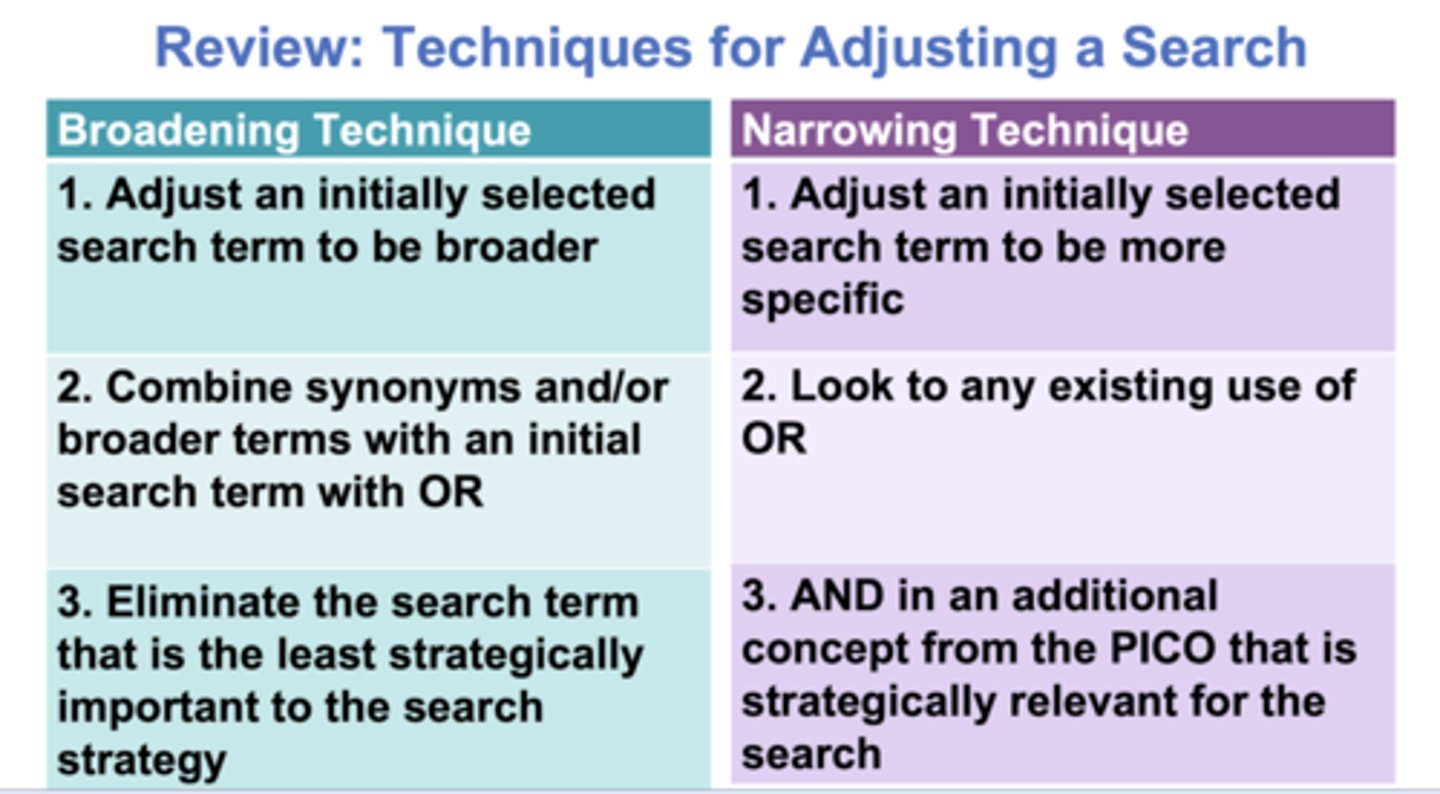
How should we sort results on PubMed?
Sort by publication date - helps rapidly identify the most recently published information and allows you to see the trends in the scholarly conversation
- Use filters if applicable (results by years, age, sex, language, etc)

What is a working set?
-This is the search you would put into PubMed to look for relevant articles
- Includes each relevant part of the PICO question with "AND" and has synonyms with "OR" and words and their synonyms are boxed together in the same parentheses
- This allows you to share with others how you got what research articles with others
What are signs of a bad working set?
- Getting too many results (in the thousands) or too few results (10-29)
- Be conscious, the working set could still be awry even if it does not meet these criteria because the articles could not be relevant
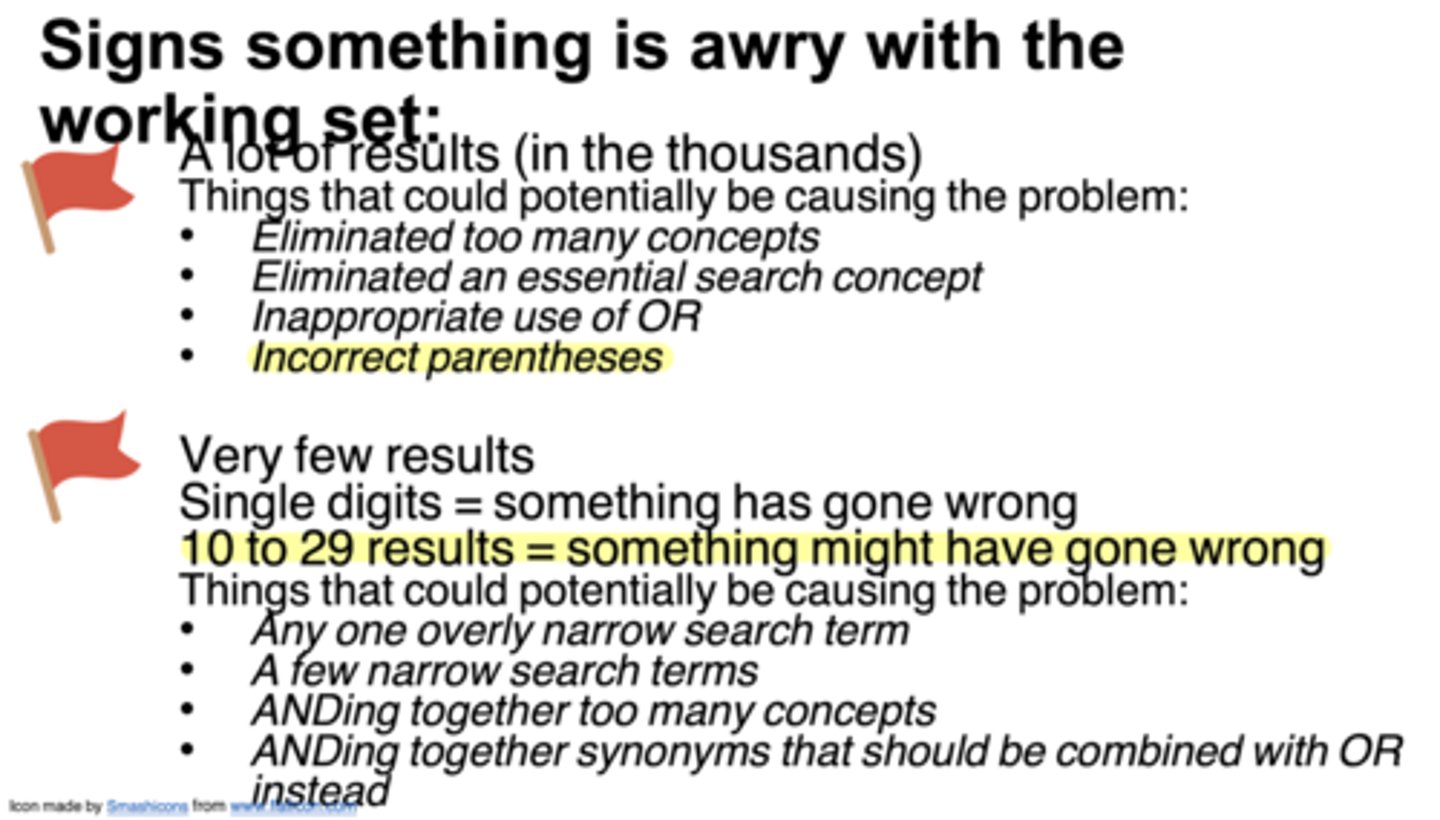
How you could have gotten too many results from a working set?
- Eliminated too many concepts
- Eliminated an essential concept
- Used OR incorrectly
- Used parentheses incorrectly
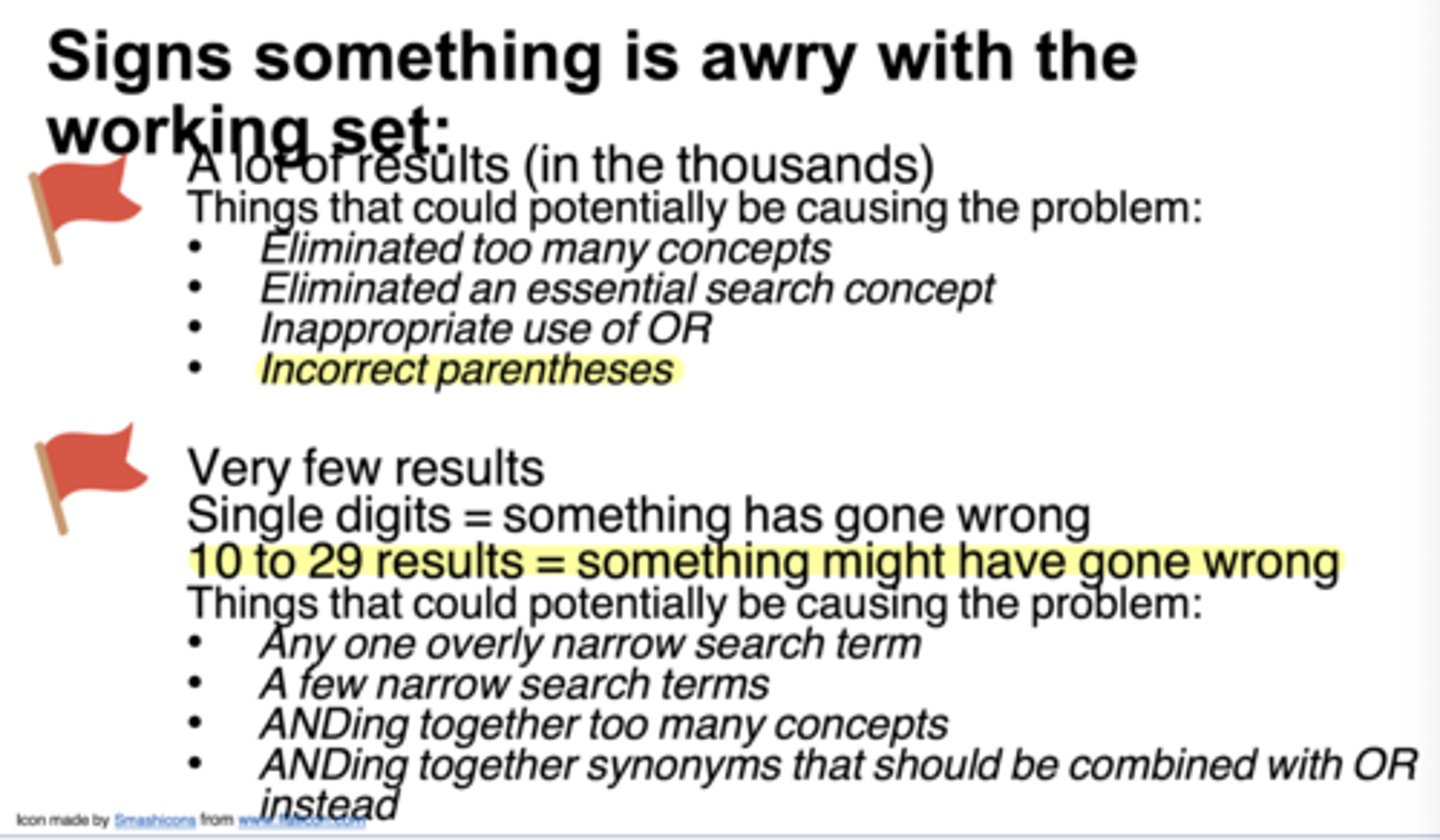
How you could have gotten not enough results from a working set?
- Having a narrow search item
- Having a few narrowing search items"
ANDing" too many concepts
"ANDing" together concepts with their synonym that should have been "OR"
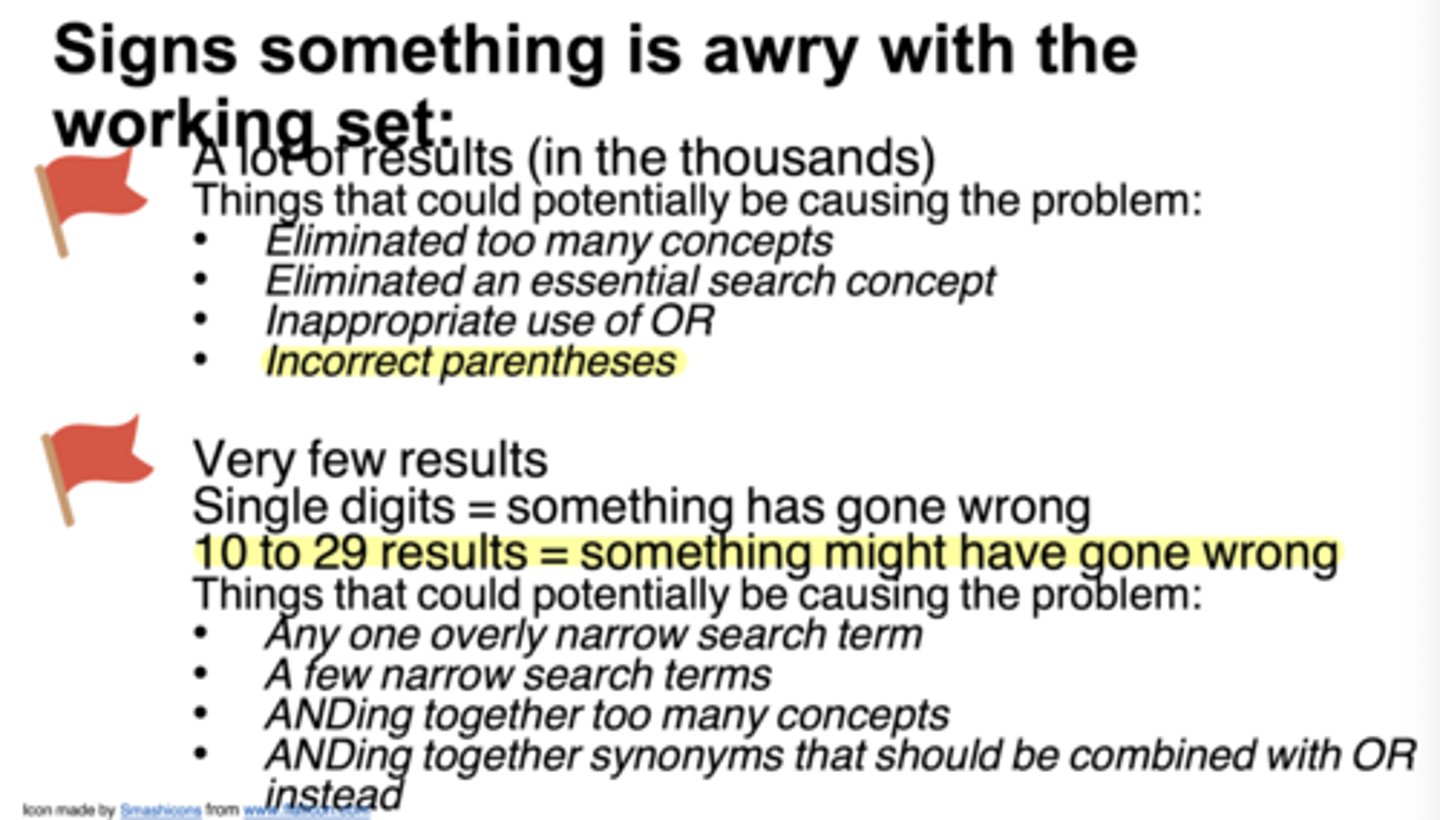
How can you improve the following working set?
(cetylpyridinium chloride OR mouthwash) AND essential oil AND gingivitis = 132 results
Error:
OR should be used between synonyms or a narrower term and a broader term for the same concept
Fixed:
cetylpyridinium chloride AND mouthwash AND essential oil AND
gingivitis = 19 results
How would you fix the error in this working set? mouthwash AND essential oil AND cetylpyridinium chloride OR CPC AND gingivitis
Place parentheses around cetylpyridinium chloride OR CPC
Do you see an error with this working set? mouthwash AND (cetylpyridinium chloride OR CPC) AND (essential oil OR essential oils OR tea tree OR lemon grass) AND (gingivitis OR
gum disease OR gum inflammation) = 37 results
No errors!
How would you fix the error in this working set? mouthwash AND (cetylpyridinium chloride OR essential oil) AND gingivitis = 233 results
Combine cetylpyridinium chloride and essential oil with AND instead of OR
Tufts Guidelines for Use of Generative AI Tools:
These guidelines come from Tufts Technology Services:
1. Protect confidential data
2. You are responsible for any content that you produce or publish that includes Al-generated material
3. There is almost never "no contract"
4. Adhere to current policies on academic integrity
5. Connect with TTS before procuring generative Al tools
Tips for using generative AI responsibily:
- Don't use Al tools to do work that you can't check yourself
- Always check where a large language model is drawing information from
- - Some models will automatically cite sources (Copilot)
- - Some models will include sources if you ask for them in the prompt (ChatGPT40)
- Cite or acknowledge your use of generative Al tools
- Educate yourself about the conditions and limitations of the model(s)you choose to engage with
How is the difference between PubMed and GoogleScholar best and most accurately defined?
PubMed is the professional standard because its inclusion criteria account for source quality and because it discloses its data management policies and search algorithms. Google Scholar has limited inclusion criteria and does not disclose search algorithms or data management policies.
The working sets below are investigating the following PICO:
P: Patients requiring tooth extraction who have undergone head and neck radiotherapy
I: Hyperbaric oxygenation
C: Antibiotics
O: Prevention of osteoradionecrosis
All of these working sets were built off of these initially selected search terms:
tooth extractionhyperbaric oxygenationantibioticsosteoradionecrosis
Only one of the working sets below does not contain an error demonstrated in the Literature Search Skills session.
Which working set below is free of all errors?
A) hyperbaric oxygen AND (antibiotics OR tetracyclines) AND osteoradionecrosis = 85 results
B) (tooth extraction OR osteoradionecrosis) AND hyperbaric oxygenation AND antibiotics = 56 results
C) tooth extraction AND hyperbaric oxygenation AND antibiotics OR tetracyclines AND osteoradionecrosis = 25 results
D) tooth extraction AND osteoradionecrosis AND antibiotics = 32 results
A) hyperbaric oxygen AND (antibiotics OR tetracyclines) AND osteoradionecrosis = 85 results
The working set below investigating the PICO given in Question 2 contains an error.
((((oral surgery) AND HBOT)) OR (hyperbaric oxygen) AND antibiotics) AND osteoradionecrosis = 83 results
How is the error best fixed?
Delete existing parentheses and properly place them around hyperbaric oxygen OR HBOT.
What is research design?
The "road map" for the research journey to find answers to the research question in a valid, objective and accurate manner
What does the following:
- Formulates an operational plan required to complete the study.
- Ensures that the methods will provide valid, objective and accurate answers to the research question.
Road map for the research journey
What does a research design include?
- Study design
- Selection of subjects
- Methods for data collection
- Methods for data analysis
- Rational and justifications
- Communication of findings
What research design focus on ideas, words, stories, impressions, and feelings?
Qualitative research designs

What research design focus on NUMBERS?
Quantitative research designs

What is qualitative research?
Provides a more holistic view of the research study, including information that cannot be reduced to numbers.
What is phenomenology
Based on the ways subjects think of and understand the world.
In this view, reality is relative and subjective. (e.g. patient satisfaction with health care).
Qualitative
Narrative research
Based on the personal stories that the subjects share with the researcher.
The storyline reflects the importance to the subject (e.g. back pain, TMJ themes)
What is a non-experiemental study?
This cause has already occurred. The researcher retrospectively links the outcomes to the cause
<---- Looking back in time
Experimental study (draw a diagram)
Tries to establish cause-and-effect prospectively
(e.g. evaluation of new therapies or procedures).
1. Group of subjects (i.e. cancer patient)
2. Intervention /treatment
3. Look at the different outcomes to draw conclusions.
Quantitative
Observational study (draw a diagram)
Do not include a research intervention; they explore association or correlation between factors to establish the development of a condition prospectively (smoking and cancer).
1. Group of subjects (chain smokers + non-smokers)
2. Follow up over time
3. Look at the different outcomes to draw conclusions (No cancer vs oral cancer)
Quantitative
Qualitative Research
Involves the analysis of words, pictures or objects to explore / describe a situation, process or experience.
The researcher interprets the data during the collection process, and the process is naturally subjective
Quantitative Research
Involves the analysis of numerical data to explain a defined research hypothesis.
The researcher aims to remain objective and control the conditions of the research.
The main approaches of quantitative research are non-experimental, experimental, and observational studies.
Mixed Methodology
The use of both qualitative and quantitative methods together in a research study.
Investigation of causality (quantitative) and focus on the content and value of the information (the personal aspect, qualitative).
A Cohort Study is...
Quantitative
Non-experimental
Prospective OR Retrospective
A Randomized Controlled Trial is...
Quantitative
Experimental
Prospective
A Case Control Study is...
Quantitative
Non-experimental
Retrospective
A Narrative study is...
Qualitative
Non-experimental
What is a Randomized Controlled Trial?
- Study population groups are randomly assigned to become control or experimental groups.
- Any subject has an equal chance of becoming a part of either groups.
- Any treatment modality has an equal chance of being assigned to any of the groups.
What is a case control study?
The study starts with affected subjects, and is retrospective, looking back in time to analyze causal factors for the illness.
- The subjects are chosen among patients and matched healthy controls.
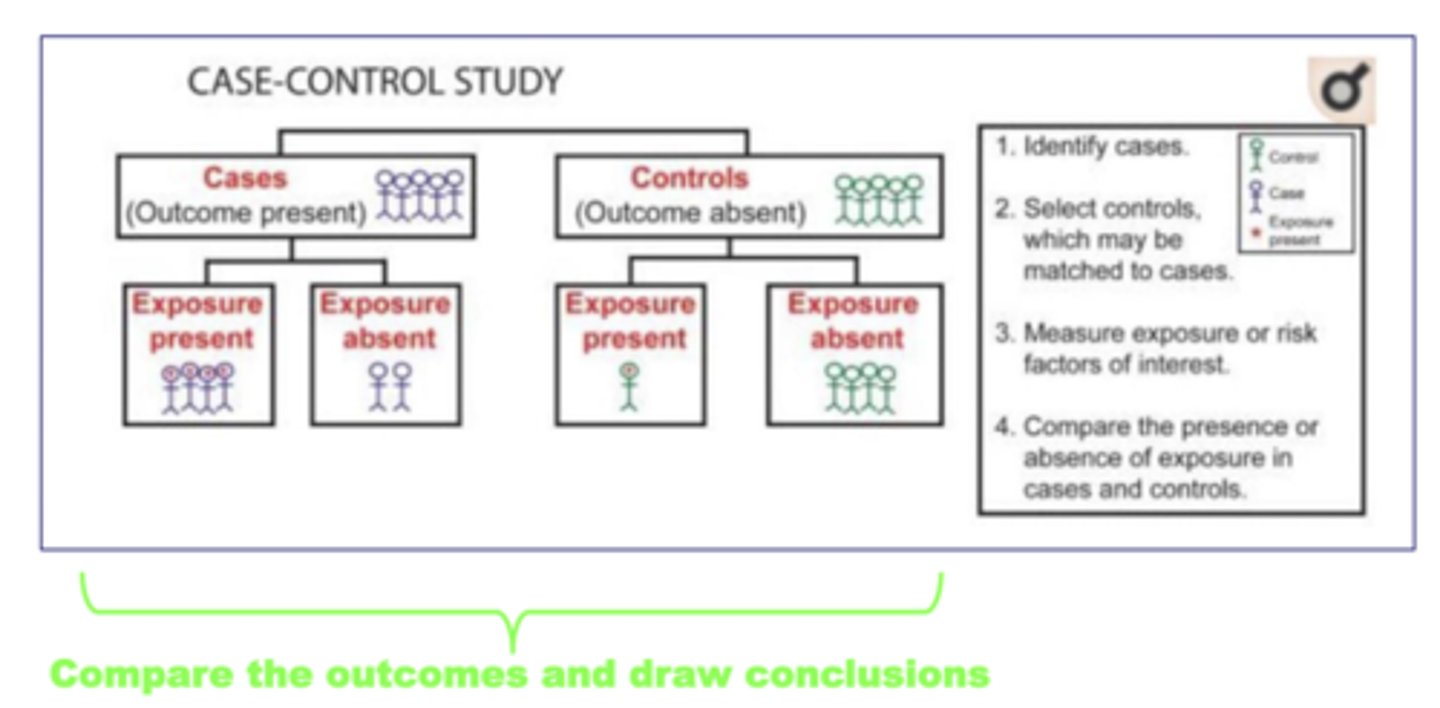
What is a cohort study?
Groups of subjects with a common characteristic (i.e. year of birth) are studied over a long period of time to follow trends of the relation/association between causal factors and development of an illness, or the prevalence of a disease.
- The study could be prospective or retrospective
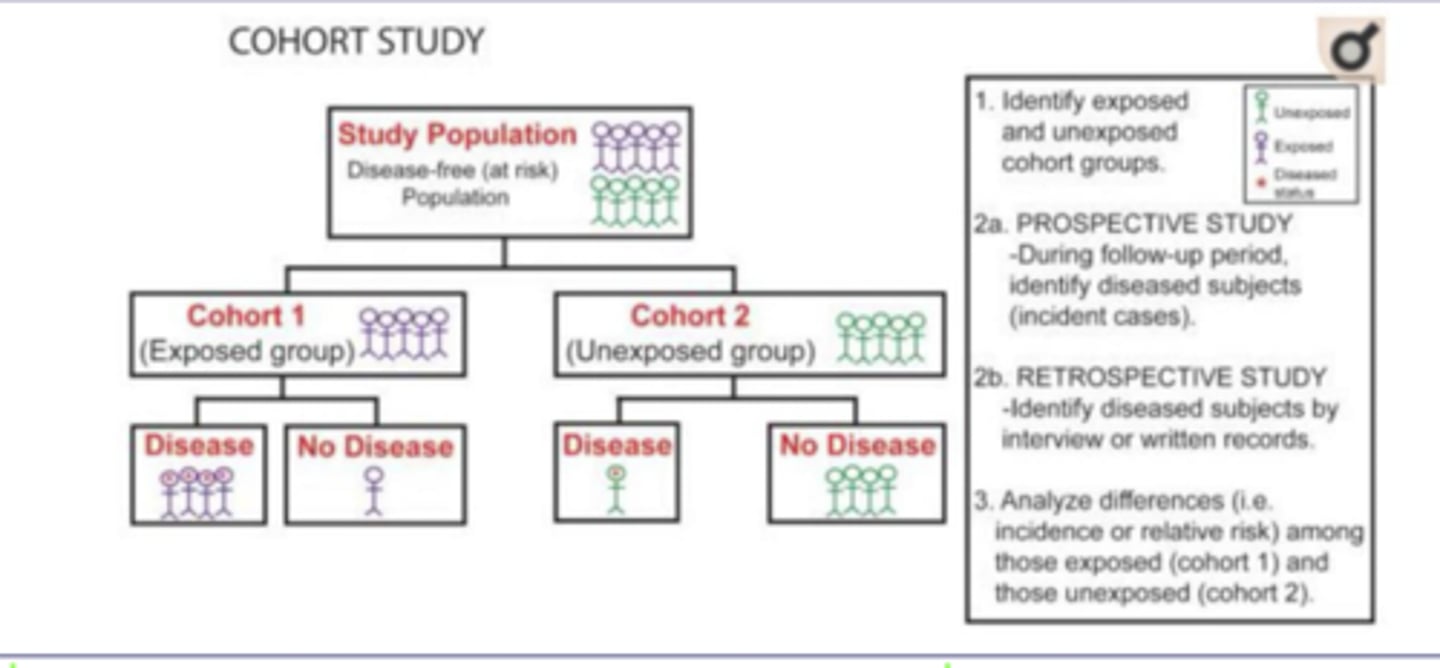
Identify the study design described:
1. Reports the treatment of a single patient
2. An exam-inaction of a sample of the population of interest (w the same condition) at a specific point in time
1. Case Report
2. Case Series
Identify the study design described:
1. A systematic review presents the results of a number of original studies that have been systematically searched out and judged on a defined inclusion criteria. Compares studies, summarizes outcomes and draws conclusions.
2. Combination of results from several independent trials
1. Systematic review
2. Meta-Analysis
Identify the study design described:
Participants are assigned randomly to a control or a treatment group that receives a specific intervention
Randomized controlled trials
Identify the study design described:
Two or more groups of people who have a different exposure to a specific agent (i.e. smoking, surgery) are selected and followed up to find the differences between the groups for specific outcomes.
Cohort studies
Identify the study design described:
Retrospective analysis of individuals with a specific condition (cases) that are matched with those without that condition (controls).
Case-control studies
Identify the study design described:
An examination of a sample of the population of interest at a specific point in time
Case series, cross-sectional studies/surveys
Identify the study design described:
A report based on a single patient.
Case reports
Identify the study design described:
A consensus from experts in the field.
Expert opinion
Identify the study design described:
Highly controlled and precise experiments that may have questionable relevance to human condition
Animal/lab research
Hierarchy of Research Design in Evidence-Based Dentistry (Highest to lowest)
1 Systematic reviews and meta-analyses
2 Randomized controlled double blind studies
3 Cohort Studies
4 Case-control studies
5 Case series (cross-sectional studies /surveys)
6 Case reports
7. Ideas, Editorials, Opinions (expert opinion)
8 Animal and laboratory research
9 In vitro research (test tube research)
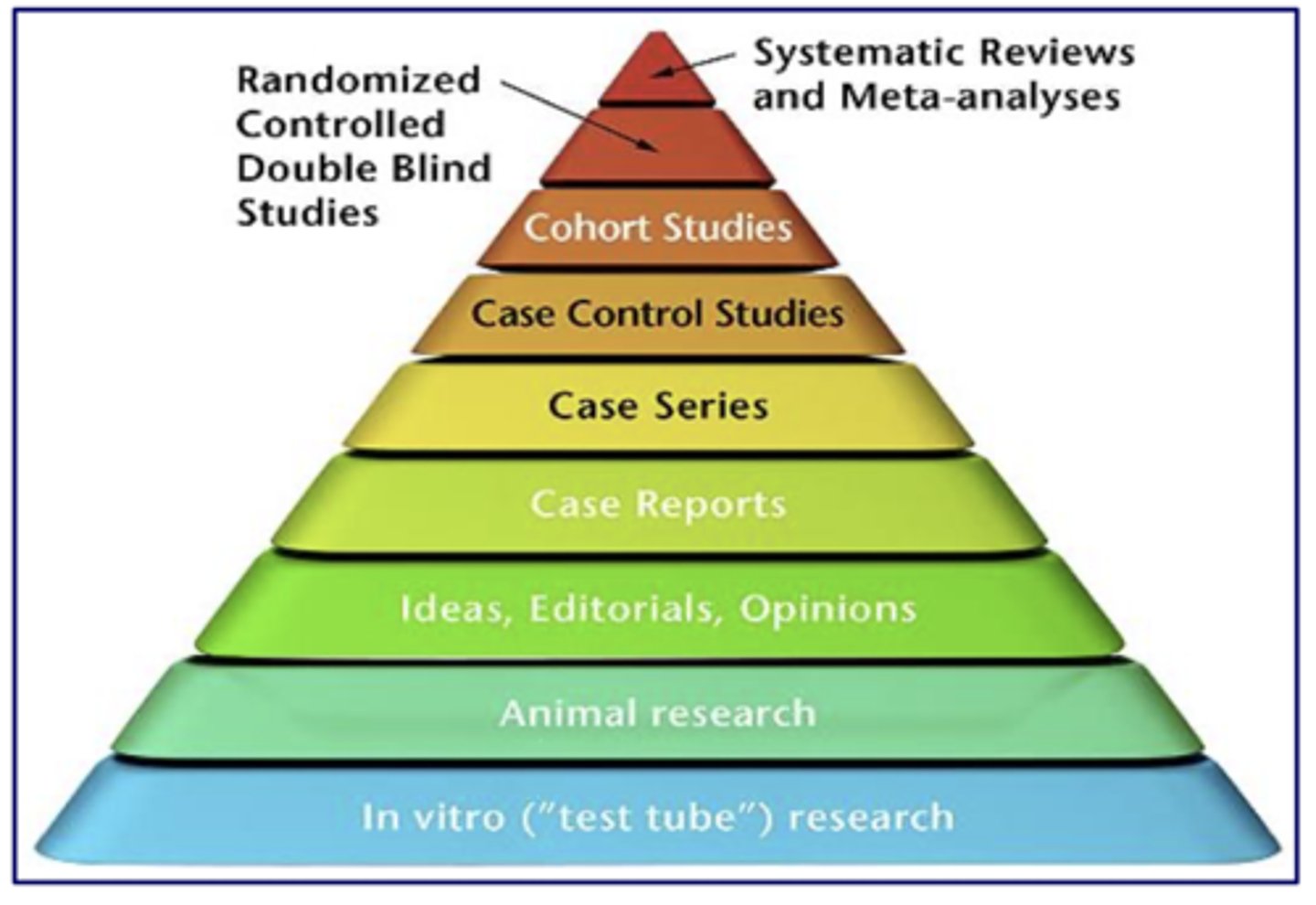
What is the purpose of Hierarchy of Research Design?
The traditional hierarchy of research designs that will provide the most reliable evidence for the effectiveness of an intervention
Least powerful evidence: Case reports and opinions
Most powerful evidence: Multi-center clinical trials
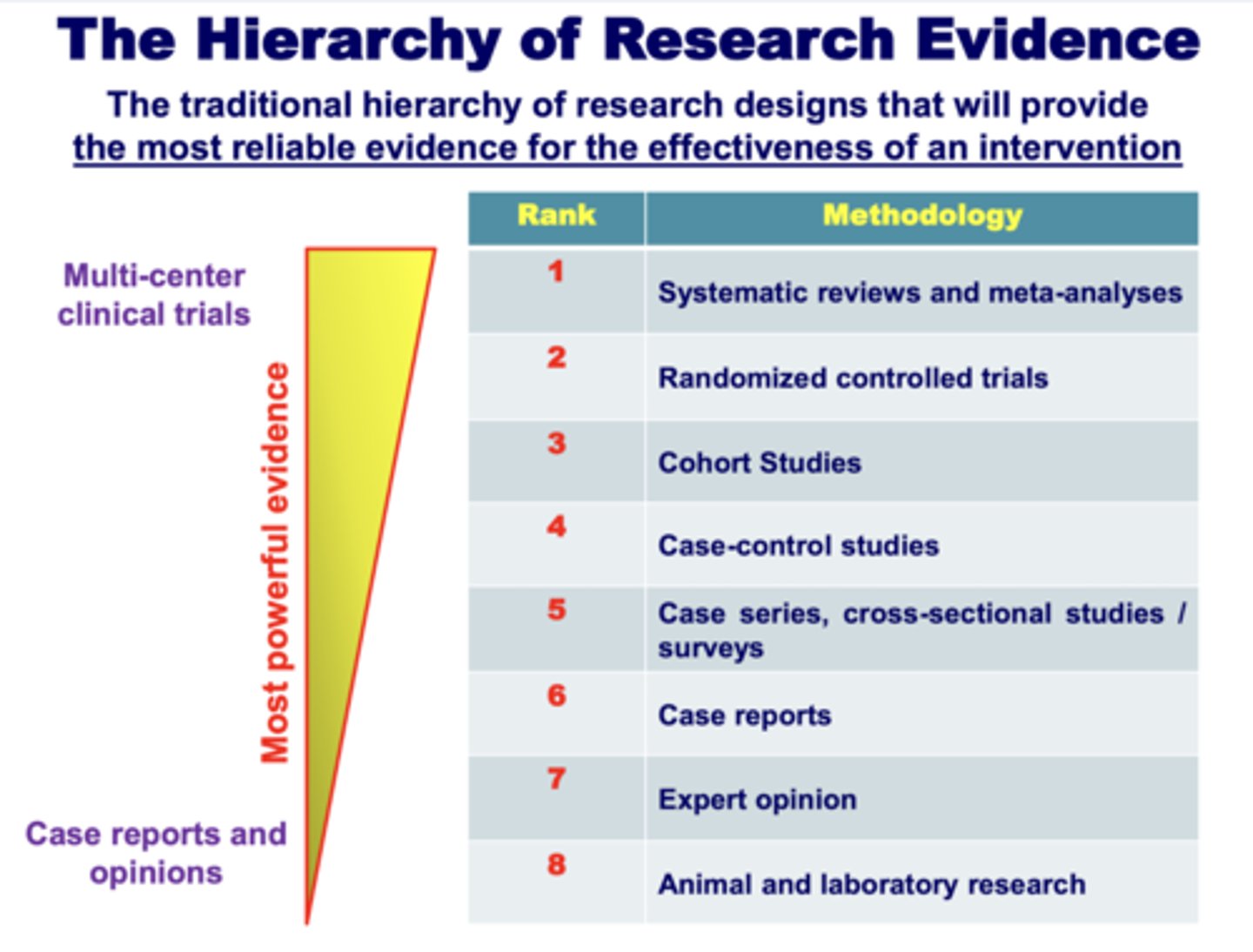
What is a case report?
A detailed report of the case (diagnosis, treatment, response to treatment and follow-up with an individual patient)
What is a case series?
Several individual cases that are aggregated and reported together
Qualitative or Quantitative?
Verbal data
Qualitative
Qualitative or Quantitative?
Analyzed statistically
Quantitative
Qualitative or Quantitative?
Explores the meaning, deeper understanding
Qualitative
Qualitative or Quantitative?
Uses focus groups and interviews
Qualitative
Qualitative or Quantitative?
Tests a hypothesis
Quantitative
Qualitative or Quantitative?
The researcher can interact with study subjects to better understand their views
Qualitative
Qualitative or Quantitative?
Study design, data collection, analysis and interpretation is flexible. The researchers may evolve their view of the research problem
Qualitative
Qualitative or Quantitative?
Test theories by creating numerical data that is statistically analyzed.
Quantitative
Qualitative or Quantitative?
Use a sample of a population in order to make extrapolation about the whole population from the result of the smaller sample.
Quantitative
Qualitative or Quantitative?
Data can be collected prospectively (from the start of the study forward) or retrospectively (searching back through data bases).
Quantitative
Qualitative or Quantitative?
Data can be analyzed to study changes over time (longitudinally) or to observe an occurrence at a specific time point (cross-sectional)
Quantitative
Qualitative or Quantitative?
Based on the philosophy that there may be more than one world view; different researchers can interpret the same data in different ways
Qualitative
What does Cochrane Library publish?
Publishes systematic reviews of medical research findings, health-care interventions, and diagnostic tests to facilitate evidence-based choices faced by health professionals, patients, and policy makers
Draw a diagram of a Randomized Controlled Trial
1. Group of patients
2. Control group + Treatment group (random assignment)
3. Follow up for each group
4. Compare the outcomes of the two groups and draw conclusions
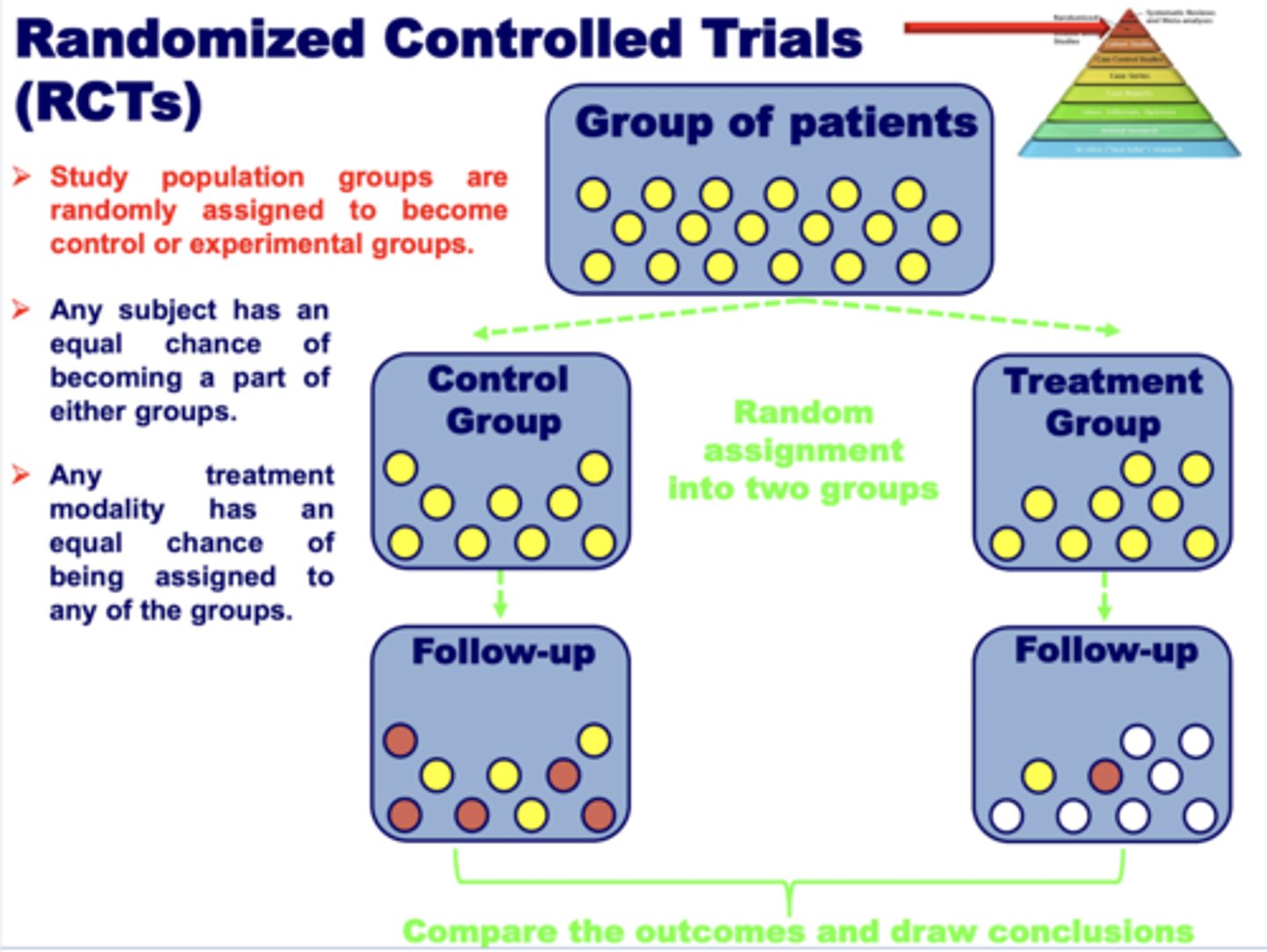
Draw a diagram of a Cohort study
1. Group of subjects (Smokers) + Comparison group (Non-smokers)
2. Follow up for both groups (incidence of cancer)
- Prospective: During follow-up period, identify diseased subjects (incident cases).
- Retrospective: Identify diseased subjects by interview or written records.
3. Compare the outcomes of the two groups and draw conclusions
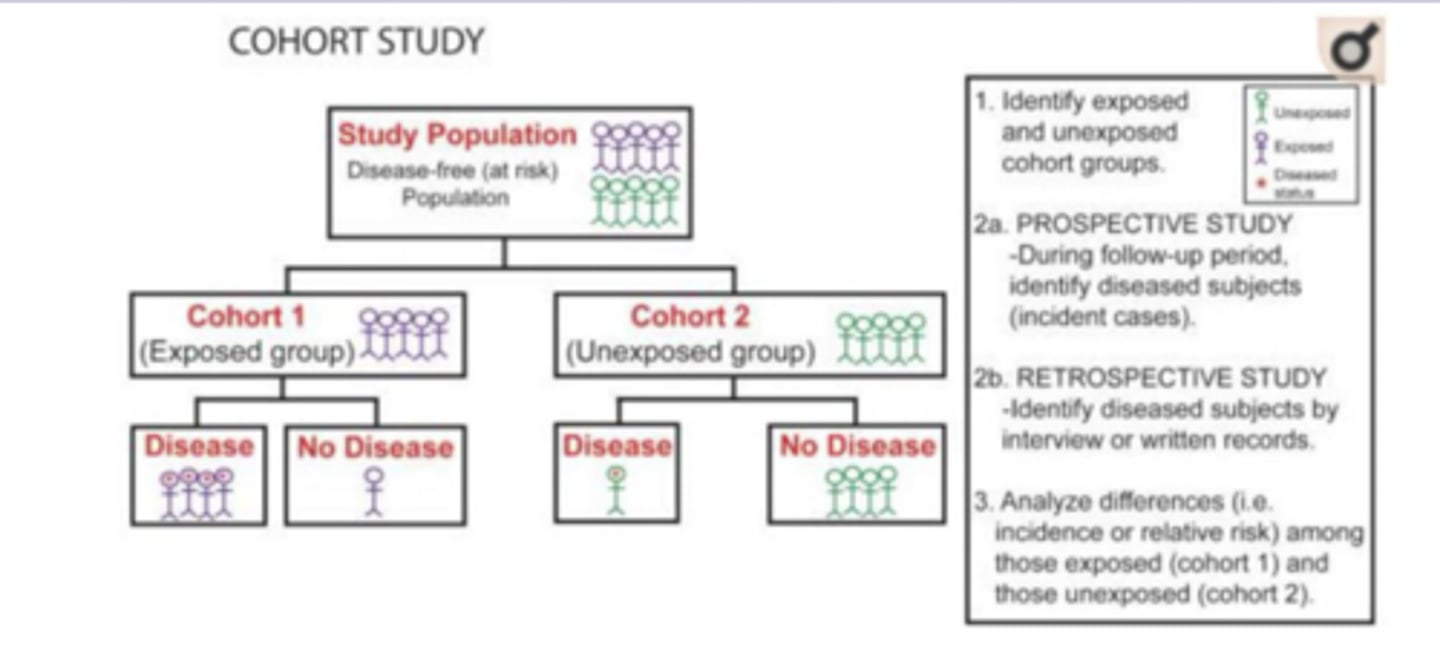
Draw a diagram of a Case Control study
1. Group of subjects (cancer patients) + Comparison group (healthy people)
2. Collection of medical history/questionnaires/etc.
3. Compare the outcomes of both groups and draw conclusions

Draw a diagram of a Case Series/Case Reports
1. Group of subjects (cancer patients)
2. Collection of medical history (patient charts, etc.)
3. Compare medical histories / charts and draw conclusions
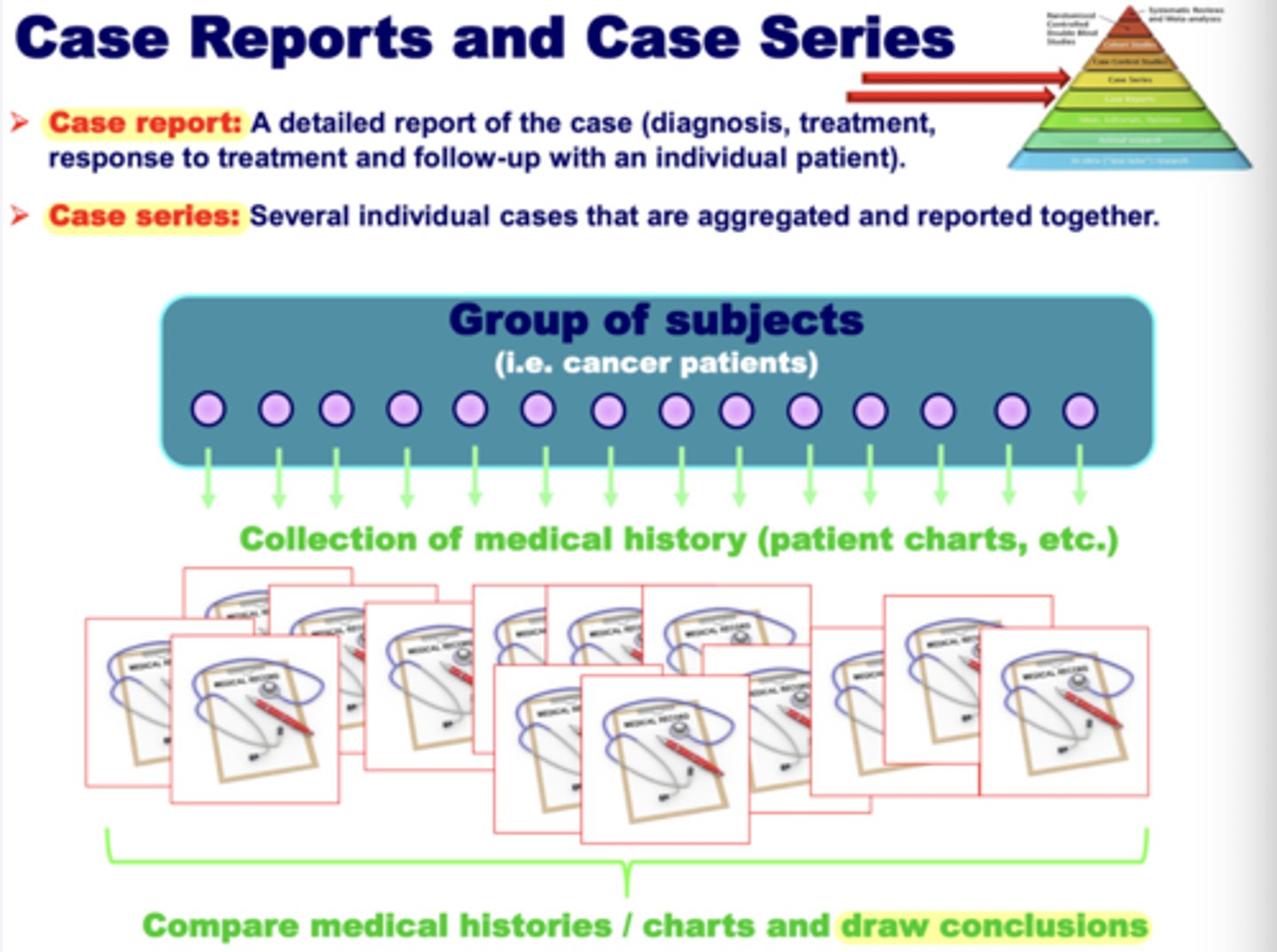
Define cross sectional study and longitudinal study
Cross sectional study: study occurrence at a specific time
Longitudinal: studies changes overtime
Prospective vs. Retrospective studies
Prospective: studies looking into the future
Retrospective: studying events that may occurred in the past i.e searching databases
How to Choose the Right Research Design?
Think about:
1. What type of evidence are you looking to generate? Are you trying to prove a point (quantitative) or understand something better (qualitative)?
2. What research design other people used to answer similar questions in a different/similar topic?
3. If you need a quantitative approach, use the hierarchy of evidence as a guide to produce the highest possible level of evidence.
4. If you need a qualitative approach, consider the types of information that each method will produce to best fit your question.
5. Think about your available time, budget, skills, people included in the study, and the help from your mentor.
A study published in 2022 is described as follows: 8640 patients with dementia and no periodontitis, and 8640 individuals without dementia history and no periodontitis were followed over a period of 10 years. The study documented the number of individuals in each group that developed periodontitis over 10 years, to determine whether the relative risk of developing periodontitis in patients who had dementia was significantly higher than in the group with no dementia history.
What type of study is described above?
Cohort study
Why know about statistics?
- Some of you will be conducting research (Need to know statistical principles)
- All of you will continue reading articles (Need to understand the "Results" section)
- Good topic to know about in your daily lives (We're surrounded by statistics; If you learn about it, you'll be more informed)
What are the 4 myths of statistics?
Myth #1: "If you're not a statistician, you don't need to know about statistics"
Myth #2: "Statistics is super impossible!" (it can be intuitive!)
Myth #3: "Statistics is about lying" (we can use statistics to find the truth, not hide it)
Myth #4: "Statistics is boring"
What is a statistic?
A number that comes from a sample. Used to draw conclusions about the entire population.
Yu et al (2024) study: We are interested in the % of dental patients who had "visible heavy plaque" on teeth. We compared current smokers vs. non-smokers in terms of this % and it showed that 82% of smokers had heavy plaque and 68% of non-smokers had heavy plaque. Based on the sample results... can we conclude that smokers and non-smokers really are different?
What is the right way to think?
In our sample,
- 82% of smokers had heavy plaque
- 68% of non-smokers had heavy plaque
A sample is a small portion of the total population
- Do our sample results give enough evidence that smokers and non-smokers are different, in the entire population of people?
- Is the difference "real" or could it be due to random chance? --> Use statistics
What would be more evidence supporting a hypothesis?
A) Sample: 40% of non-smokers have heavy plaque vs.55% of smokers
B) Sample: 20% of non-smokers have heavy plaque vs. 90% of smokers
B) Sample: 20% of non-smokers have heavy plaque vs. 90% of smokers
T/F: The more different the smokers' sample % is from the non-smokers', the more evidence the difference is real
True
What would be more evidence supporting a hypothesis that says men see colors differently than women?
A) Sample: 40% of men say "red" vs. 55% of women
B) Sample: 20% of men say "red" vs. 90% of women
B) Sample: 20% of men say "red" vs. 90% of women
"The more different the sample %'s, the more
evidence the population %'s are different
What is the variable for sample size?
Are your results more reliable if your sample size is smaller or larger?
Larger! With a small group, results are not as reliable so it is hard to draw definitive conclusions and the difference could be random chance
T/F: The higher the sample size, the more reliable your results will be
True!
What would be more evidence supporting a hypothesis?
A) Sample size: 9 per group
B) Sample size: 900 per group
B) Sample size: 900 per group
What is a sample size also referred to as?
"N"
Elements of a good sample
"What % of inner-city teenagers have poor oral hygiene?"
Quantity: N count should be high enough to draw reliable conclusions
Quality: Should choose a valid group of subjects
How to get a representative sample?
Simple random sampling: Choose sample "at random" from the population
Each subject has the same chance of inclusion
- It's fair
A random sample is likely to be similar to population
- It's representative
Use a computer to randomly select subjects (non-biased).
- Give everyone in the population a number (cannot be extremely large)
- Use random.org (sequence generator) or excel
- Pick the first whatever number of subjects in the sequence to be in your study. The rest are not in the study.
When can you vs can you not use random sampling?
Can use it in a small population that is easily accessible (Ex: Tufts dental students)
Can't use it when population is large and/or not easily accessible (Ex: Kids ages 6 to 10)
How should a sample be similar?
Demographics:
- % in each gender
- % in each race
Medical/dental characteristics
- % who smoke
- % who visit the dentist more than once/year
This sample is least representative in what way?
Married:
- Sample: 80%
- Population: 79%
Visiting the dentist
- Sample: 71%
- Population: 88%
Smoking
- Sample: 32%
- Population: 32%
Visiting the dentist
What is convenience sampling?
Sometimes you can't pick your sample at random
Just take what you get: "convenience sample"
Example: want to know the % of kids who brush twice a day
- Population: kids ages 6 to 10
- Sample: kids in that age group who come to TUSDM
Not as good as a simple random sample, but still worthwhile
Ways to improve your study, regardless of sampling type
1) Use proper inclusion/exclusion rules
2) Report information about representativeness
3) Avoid extrapolating or over-generalizing results
What are Inclusion rules and exclusion rules?
Rules that determine whether a subject can enter a sample
To be eligible for a study, a subject:
- Must meet all inclusion rules
- Must not meet any exclusion rules
Inclusion rules...
Tells the type of subjects we are studying (ex: adults who have chronic jaw pain)
Exclusion rules...
States specific characteristics that would NOT allow a subject to participate (ex: inability to answer a survey question)
Tips for good inclusion/exclusion rules (3)
1. Exclude subjects who will be harmed by research
Ex: pregnant woman and blood pressure meds
2. Make rules SPECIFIC, easy to "check off"
Ex: comparing different methods for treating TMD (include people with TMD and exclude people unable to answer survey)
3. Get people who have the condition you're studying and don't have another condition that can interfere/complicate
Ex: As opposed to saying including "healthy subjects," say you'll include subjects with no systemic chronic disease in the last 6 months
When a study is comparing different tooth whitening methods with a whiteness scale of 1-16, 1 being lightest, can a man with a shade of 1 before the study join?
No because he cannot improve his score (need to get people who have the condition you're studying for)
Next time add an inclusion rule, ex: only people who could use tooth whitening at the start
What should you do if your sample % is a lot different than the population %
List that as a limitation in your research paper. (Say sample not absolutely representative of population)
(Put the % table in the paper/poster as well)
